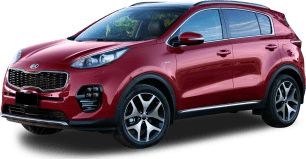How many seats does a Hyundai Santa Fe have, you may ask. Well, Hyundai has equipped the Santa Fe as a seven seater with a third row pair of rear seats that fold completely flat into the floor. How many seats do you need? That’s a question only you can answer…
These seats are quite generously sized and the rear section has its own air vents and bottle holders to make passengers a little more comfortable. The second row of seats slides fore and aft, and the backs can be adjusted to give those rear seaters a little bit more room if required. Being able to juggle the second and third row of seats does mean a little bit more leg room can be found when required - as long as the other passengers aren't too tall.
While adults could clamber in and be safely seated in that area, it is definitely still an area better suited to smaller humans.
Second row passengers will need to share a single 12-volt power outlet on their centre console bin, while their air vents are situated in the B pillars. ISOFIX baby seat mounting points are attached to both outside rear seats.
The interior of the Santa Fe is quite spacious, and even with the standard full length sunroof, headroom in front and back is plentiful, while rear leg room in the middle row is excellent.
Up front the driver and passenger have plenty of room to get comfortable with broad medium/firm seats. They could be perhaps a little bit lower in the car, but it's only by a couple of millimetres.
Visibility around the car is good with extra-large sized door mirrors and a porthole through the rear most pillar. The rear window aperture is quite narrow, but visibility is still okay.
Combined with that slightly too-high seat is a steering wheel that also sits slightly too low perhaps for taller drivers, although it is adjustable for both reach and height.
There are a lot of controls in the Santa Fe; there's not a lot of consolidation of buttons with a panel to the right of the driver's hand controlling things like drive mode, lane departure control, parking sensors and hill descent mode.
The centre console is quite crowded as well and the climate controls could be perhaps a little bit clearer to use, but it only takes a couple of minutes to get familiar with them.
The multimedia system's graphics are quite good, especially for an established model, and the addition of a reasonably seamless Apple CarPlay experience certainly adds to the drive experience of the Santa Fe.
There are plenty of power points at the front with a pair of 12 volt (12V) plugs, along with a USB cable input, and a pair of side by side cup holders reside in front of a medium-deep centre console bin that comes standard with a phone tray in the top.
There's plenty of storage on all four doors for large bottles and it's nice to see that the pockets are partitioned to stop items from rattling around unnecessarily.
At 1615 litres VDA luggage capacity with the seats down, the Santa Fe’s dimensions lag behind both Toyota’s Prado (1833L) and Kluger (1872L) in total area, but it beats the Prado for boot space when only the second-row seats are in place, and is line ball with the Kluger, at 516L.
However, there is almost no room when the third row is up, which again raises the issue of just how impractical seven-seaters are when actually used as seven-seaters. Luckily, roof rack rails allow for additional storage options to be explored.
The Santa Fe will take a full size bicycle without the wheels removed with the 40/20/20 split-fold seats folded flat into the floor. Hyundai offers a clever recess for the cargo cover underneath the floor, but no cargo liner/tonneau cover is included as standard. A barrier can be fitted aftermarket if required.
A full sized spare tyre resides, 4x4 utility-like, behind the rear bumper under the floor of the cargo area.








.png)



































.png)




























